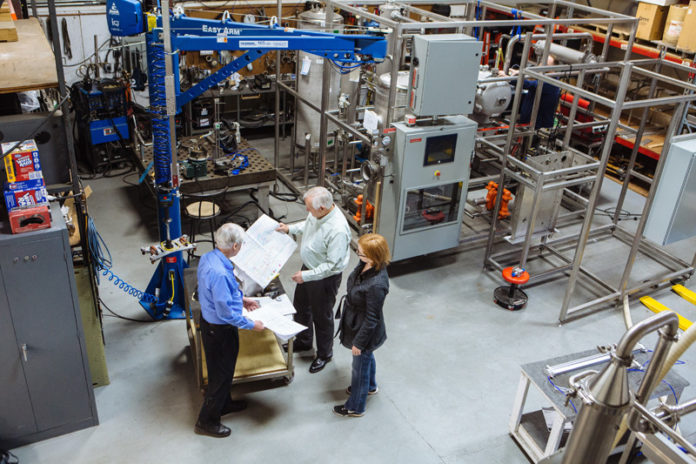
Many of the toxic chemical solvents that industries tossed into landfills years ago – creating the need for expensive federal cleanup efforts by the end of the 20th century – were used to clean industrial parts.
A cleaning system for these parts that uses fewer chemicals and is easier on the environment is just what Vacuum Processing Systems LLC of East Greenwich has created.
The company’s Vacuum Cycle Nucleation system cleans industrial components in a controlled vacuum chamber with either water or solvents. It bubbles and scrubs foreign bodies into oblivion from even hard-to-reach crevices and imperfections, doing so with little or no chemical residue.
The system needs only a low concentration of chemicals to lift the foreign material from the surface of what’s being cleaned, company principal Joseph Schuttert explained, and the system encloses the chemicals within the chamber. This, he said, lowers the amount of chemistry that remains. “Most other cleaning processes will use as much as a 10 percent concentration while our process uses only 1 percent or less,” he said. Plus, the chamber recovers 97 percent of the chemistry for reuse.
The system reduces the amount of soap or acids necessary for the cleaning, company principal and system inventor Don Gray said, meaning less waste, another benefit to the environment. “Disposable material is reduced by a total of 80 percent,” he said.
The system thoroughly cleans and sterilizes a wide range of products and equipment that include medical devices, sensitive industrial instrumentation, 3-D printed parts, industrial fittings, internal bearings, pharmaceutical equipment, heart and other medical implants, dental implants, hypodermic needles and even jewelry.
“We cover a lot of areas,” Gray said simply.
The cleaning of 3-D printed parts is a big example of what the VCN system does better and faster, Schuttert said. Small distributors will clean these parts for customers, but a lot of residue or fillers still remain. “They may typically take hours or days to clean 3-D parts,” he said. “We get it done in a matter of minutes.”
And the future looks bright for VCN and Vacuum Processing Systems.
Schuttert noted that the VCN process is the first significant development in industrial component cleaning and surface preparation in about 40 years, “which is about how long ago ultrasonic cavitations began seeing use in manufacturing. In fact, we recently began talks with the leading supplier of ultrasonic cleaning equipment to add our process to their equipment,” he said.
The company is constructing a system for a Fortune 100 company’s 3-D printed parts.
“We are told that without our process, the multimillion dollar project would have had great difficulty going forward. The project will have a significant effect on aviation and power generation. That is about all I can say about it,” said Schuttert.
Water Corp.’s Milford, Mass., micro-machining department is glad it adopted the VCN system. After using it to remove sub-micron particles and debris from the metal components used to assemble its life-science instrumentation, the company, in a recent press release, concluded that the system “has reduced processing times, rejection rates … and has reduced chemistry consumption by 200 percent.”
Gray and Schuttert started a company designing and building cleaning systems in 1994, but split because Gray was busy as a chemical-engineering professor at the University of Rhode Island. The two became a team again five years ago, when Gray, who had just invented the VCN system, retired from teaching.
Now, Gray is proudest of the fact that the system he invented and patented is good for the environment.
Schuttert, who holds a degree in biology and recently retired from the pharmaceutical industry, is proudest of the company’s ability to perform thorough cleaning of industrial components to a level that hasn’t been achieved before, showing VCN as a true green leader. •












